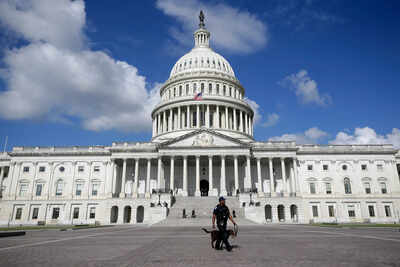
The United States is once again staring at a possible government shutdown. Unless Congress agrees on a funding deal before midnight on September 30 large parts of the federal government will run out of money and be forced to close from October 1.Here’s what’s happening and why it matters.
What is a government shutdown?
A shutdown takes place when lawmakers fail to pass a funding bill for the new fiscal year. Without that money, many federal agencies cannot function and must halt all non-essential work until Congress acts.Essential services, such as social security, the military, immigration enforcement and air traffic control, continue. Mail delivery also goes on as usual. But other areas face disruption. In the past, shutdowns have closed national parks and Smithsonian museums, delayed immigration hearings, slowed air travel and disrupted food safety checks.The longest shutdown so far lasted 34 days in 2018 under Donald Trump, leaving around 800,000 government workers without pay, according to The Guardian.
Why is it happening now?
In the US, the new fiscal year begins on October 1, but Democrats and Republicans are deeply divided.
- Earlier this week, Donald Trump cancelled talks with Democratic leaders, calling them “unserious” and not “productive”.
- Democrats, led by Senate minority leader Chuck Schumer and House minority leader Hakeem Jeffries, accused Trump and Republicans – who control both chambers – of pushing the country towards a shutdown.
- Last week, the Senate rejected competing short-term funding bills, while the Republican-controlled House passed one that nearly all Democrats opposed.
Democrats want more than just a temporary funding patch. They are demanding:
- an extension of subsidies that lower health insurance costs under the Affordable Care Act,
- a reversal of Medicaid cuts made in Trump’s One Big Beautiful Bill Act, and
- the restoration of funding for public media.
Republicans have dismissed these demands. Senate majority leader John Thune told CNN they were “completely unhinged and unreasonable and unserious”. He added, “If they want to have a serious conversation, I think that I’m sure the president would be welcome or would be happy to do that.”Schumer hit back on X, saying, “What’s ‘unserious’ is ignoring the 93% spike for health insurance coming to Americans on November 1.”
Why is this shutdown more serious?
In a new step, the White House has told agencies to prepare not only for temporary furloughs but also for permanent layoffs. A memo from the Office of Management and Budget instructed departments to draw up redundancy notices for programmes that would lose funding and are “not consistent with the president’s priorities”.The OMB has already overseen workforce cuts under Trump’s efficiency drive led by Elon Musk’s “department of government efficiency”.Liz Shuler, president of the AFL-CIO, criticised the plan, saying workers had “already suffered immensely” from the administration’s cuts. “They are not pawns for the president’s political games,” she said, as quoted by The Guardian.Trump has insisted Democrats are to blame, “They never change,” he said.Jeffries replied that Democrats “will not be intimidated” by the threats. He had a blunt message for OMB chief Russell Vought: “Get lost.”
How will government departments function?
Department of education:
In case the shutdown takes place, only a few DoE employers would continue working, as per the agency’s updated plan released on Sunday, CNN reported. Under the plan, almost 1,500 of the department’s 1,700 employees would be furloughed, along with about 650 of the 750 staff members at the Office of Federal Student Aid.
Department of defense:
According to the Pentagon’s contingency plan, around 224,000 of its more than 741,000 civilian staff would remain on duty to protect life and property, alongside nearly 2.1 million military personnel.
Department of homeland security:
If funding runs out, just 14,000 of the agency’s nearly 272,000 employees would be furloughed. Most staff in Customs and Border Protection, Immigration and Customs Enforcement, the Transportation Security Administration, the Secret Service, Citizenship and Immigration Services, and FEMA would continue working, according to CNN.
What could be the impact?
If the government shuts down:
- hundreds of thousands of employees may be furloughed or asked to work without pay,
- services beyond the essential will be delayed or stopped,
- public services like museums and parks could close, and
- delays in inspections and hearings may frustrate the public.
Economists say the wider economy may not feel the shock right away. But if the shutdown drags on, it could slow growth, unsettle markets and weaken public trust in government.








